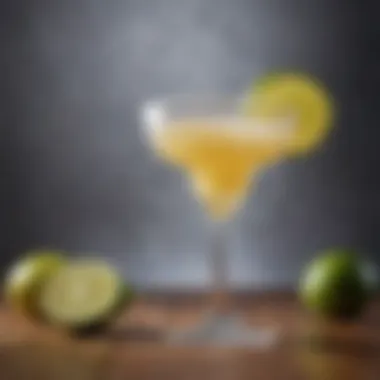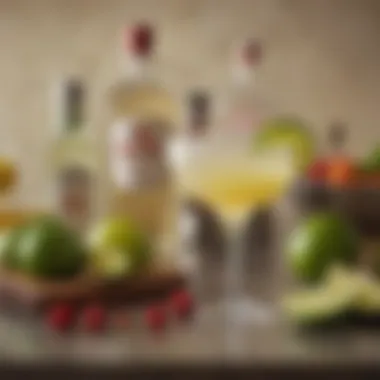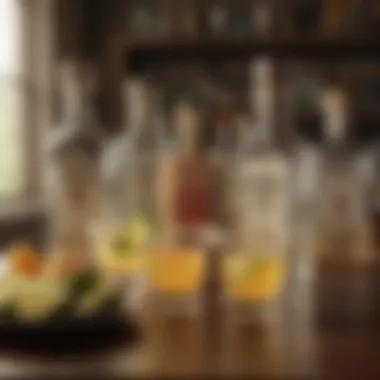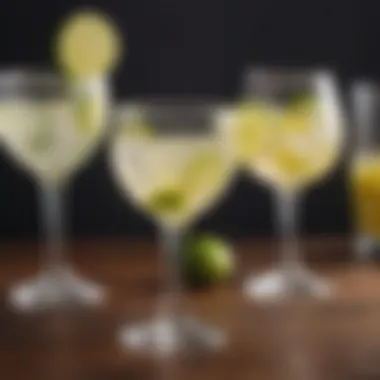Understanding the Alcohol Content in Margaritas


Intro
This article provides an in-depth look at what affects the alcohol content in margaritas. We will discuss the recipe overview, key ingredients involved, the impact of proportions, and how these factors influence the overall experience. This knowledge is particularly relevant for culinary enthusiasts looking to perfect their mixology skills.
Additionally, the implications surrounding alcohol concentration will be examined. This includes not only enjoyment but also awareness of how these beverages fit into broader social contexts.
Foreword to Margaritas
Margaritas hold a prominent place in the world of cocktails, signifying more than just a drink. They encapsulate a blend of tradition, culture, and the art of mixology. In this section, we will explore the significance of margaritas in both social and culinary contexts.
The appeal of margaritas extends across various demographics. From casual get-togethers to formal celebrations, they have become a staple in bars, restaurants, and homes. Understanding the nuances of this cocktail enriches not only our appreciation but also offers insights into its composition, especially regarding alcohol content.
- Culinary Exploration: Margaritas invite experimentation with flavors and ingredients, sparking interest in food and beverage pairings.
- Social Connections: Sharing a margarita can be an act of bonding, creating memorable experiences with friends and family.
- Cultural Relevance: Originating from Mexico, the margarita reflects elements of its heritage, resonating with those familiar with its background.
In sum, the importance of margaritas lies in their ability to connect people and cultures while providing a rich canvas for culinary creativity. Understanding the alcohol content, as well as the cultural and historical dimensions of this cocktail, sets the foundation for a deeper appreciation of one of the most enjoyed beverages around the world.
Historical Background
The history of margaritas is somewhat nebulous, with various stories attributing its creation to different individuals and locations. Most accounts suggest that the margarita originated in Mexico during the early to mid-20th century. Some believe it was invented as a variant of the Daiquiri, while others argue it was designed for an American socialite in Tijuana.
Over the years, the margarita evolved. It transitioned from a simple concoction of tequila, lime juice, and orange liqueur into numerous variations. The classic recipe has led to the creation of frozen margaritas, flavored versions, and even layerings of different spirits.
Cultural Significance
Margaritas symbolize more than just a cocktail; they embody aspects of Mexican culture and social interactions. They are often associated with celebrations, from birthdays to national holidays. The drink's vibrant colors and refreshing taste appeal to diverse palates, making it a favorite among many.
Moreover, margaritas have inspired festivals and dedicated establishments, promoting not just the drink but a lifestyle centered around enjoyment and conviviality. Their signature salt rim elevates the experience, embodying the essence of culinary craft.
"Margaritas are not just drinks; they represent a cultural experience, an enjoyment of life that many wish to partake in."
Thus, understanding the cultural significance of margaritas adds depth to our awareness of this cocktail, beyond its mere alcoholic content.
Understanding Alcohol Content
Factors influencing the alcohol content include the type of tequila, the amount of lime juice, and any additional mixers or sweeteners. This article unpacks these variables, providing insights so that enthusiasts can appreciate the nuances hidden in every margarita. Moreover, being aware of the alcohol content is vital for responsible consumption, reducing the likelihood of overindulgence.
Definition of Alcohol Content
Alcohol content is traditionally defined as the percentage of ethanol in a beverage. This measure indicates the strength or potency of the drink. In the realm of margaritas, this percentage varies widely, largely dictated by the recipe and preparation method.
Most commonly, the alcohol content is expressed as Alcohol by Volume (ABV), which quantifies how much of the liquid is pure alcohol. For instance, a margarita made primarily with tequila and minimal mixers will typically exhibit a higher ABV compared to a frozen margarita loaded with fruit purees and syrups.
Understanding this metric is essential, especially for those who wish to enjoy margaritas responsibly. Knowing the expected ABV can help individuals gauge their limits effectively.
Measuring Alcohol by Volume (ABV)
Measuring Alcohol by Volume (ABV) is an essential practice in the beverage industry. It quantifies the amount of alcohol present in a liquid and offers a clear insight into its strength. The ABV is measured in percentage terms, indicating how much of the total volume consists of ethanol. For margaritas, the ABV can swing from 10% to 20% or more depending on the setup of ingredients.


To calculate the ABV in a margarita, it is necessary to consider the volume of each ingredient and their respective alcoholic qualities:
- Tequila: Generally contains around 40% ABV. It serves as the primary source of alcohol in the cocktail.
- Orange Liqueur: Varieties like Cointreau or Triple Sec usually also range from 15% to 40% ABV, contributing to the mix’s potency.
- Lime Juice and Sweeteners: These non-alcoholic ingredients do not add direct alcohol content, yet affect the overall drink characteristics and consumption experience.
For example, if a standard margarita contains two ounces of tequila and an ounce of orange liqueur, you can determine the total alcohol content using a simple formula:
For anyone crafting or enjoying margaritas, knowing how to measure ABV holds significance for maintaining both safety and enjoyment.
Components of a Margarita
Understanding the components of a margarita is crucial for grasping how its alcohol content is influenced. Each element plays a significant role not just in flavor but also in the overall potency of the drink. Several factors contribute to how each ingredient affects the alcohol level in a margarita, making it essential for both consumers and mixologists to understand these components.
Tequila: The Base Spirit
Tequila is the primary spirit used in margaritas, forming the backbone of the drink. The type of tequila chosen can greatly influence the drink's flavor profile and potency. Generally, there are two categories of tequila: 100% agave and mixto. 100% agave tequila tends to have a more complex flavor and higher alcohol content, usually around 40% ABV. On the other hand, mixto tequila, which contains less than 100% agave, might be cheaper but often lacks depth and could have a lower ABV. Therefore, the selection of tequila directly affects the overall alcohol content and taste of the margarita.
Lime Juice: The Acidic Counterpart
Lime juice is an essential ingredient that balances the sweetness of the other components while enhancing the drink's overall flavor. Fresh lime juice is preferable, as it possesses more vibrant acidity compared to bottled varieties. The acidity of lime juice does not contribute to the alcohol content, but it significantly influences the margarita's taste. Too much lime juice can overpower the tequila, while too little may make the drink excessively sweet, which could mask its alcohol content. Finding the right balance is key to crafting a well-rounded margarita.
Orange Liqueur: Adding Complexity
Orange liqueur is added to margaritas to introduce layers of flavor. Commonly used options include Cointreau or Triple Sec, each contributing a unique aspect to the mix. While orange liqueur typically has a lower alcohol level compared to tequila, it can still impact the cocktail’s overall strength. The sugar content in these liqueurs can also affect how the drink is perceived, sometimes making it seem less potent. Responsible cocktail crafting involves careful measurement of all components, as the interplay between tequila, lime juice, and orange liqueur dictates the overall alcohol content and the grownup essence of the margarita.
"The art of making a margarita lies in the precise combination of its ingredients."
In summary, each component of a margarita is significant. Their interactions not only underline the drink's unique flavor but also its alcohol volume. Understanding the role of tequila, lime juice, and orange liqueur allows consumers to appreciate the complexities of margarita preparation.
Impact of Ingredients on Alcohol Content
Understanding how the ingredients of a margarita affect its alcohol content is essential for both mixologists and consumers. Margaritas are not just about flavor; their structure revolves around the careful selection and proportion of components. The interplay between these ingredients significantly influences the overall experience, from taste to intoxication level. A deeper look into alcoholic content helps consumers make informed choices, while also guiding bartenders in crafting the perfect cocktail.
Different Types of Tequila
Tequila, as the primary spirit in margaritas, plays a pivotal role in determining the drink's strength. There are several types of tequila, including Blanco, Reposado, and Añejo.
- Blanco: This is unaged tequila, typically bottled immediately after distillation. It tends to have a robust flavor profile with a higher alcohol content, usually around 40% ABV.
- Reposado: Aged in oak barrels for two months to a year, Reposado offers a smoother taste, often resulting in a marginally reduced perception of alcohol strength while maintaining a similar ABV.
- Añejo: Aged for at least one year, Añejo tequila brings complexity and warmth. The aging process may mellow the alcohol’s bite, making the overall margarita feel less potent, even if the alcohol content remains the same.
Consumers should consider these distinctions while enjoying margaritas, as they can affect personal tolerance levels.
Variations in Lime Juice Concentration
Lime juice is another crucial ingredient that affects not just flavor but also the alcohol content perception. The concentration of lime juice can vary between recipes.
- Fresh Lime Juice: When freshly squeezed, it offers a vibrant taste that balances the sweetness of tequila and any added mixers. Fresh lime juice is often more tart than bottled varieties, which may affect how the brain perceives the strength of alcohol.
- Bottled Lime Juice: Often contains added sugars or preservatives that can dilute the lime flavor, making the drink taste less acidic and potentially masking the alcohol's punch.


The lime juice concentration, while not directly related to alcohol measurement, can significantly alter how strong a margarita feels.
Role of Sweeteners and Mixers
Sweeteners and mixers can impact the alcohol content indirectly by affecting how consumers perceive taste. Margaritas often include sweeteners like agave syrup or triple sec, which can alter the overall experience.
- Agave Syrup: Its natural sweetness can balance the acidity of lime juice, making the margarita more palatable. However, increased sweetness might encourage excessive consumption, often leading to higher alcohol intake overall.
- Triple Sec: This orange liqueur adds complexity to margaritas. Brands like Cointreau or triple sec liqueurs vary in alcohol concentrations, typically between 15% to 40% ABV. The choice of triple sec can thus increase or decrease the drink's overall strength.
Furthermore, common mixers such as soda or fruit purees may dilute the alcohol concentration, leading to a lighter drink that may mislead consumers about the actual alcohol content.
It's essential to remember that while the ingredients may influence taste, the actual alcohol content is determined by specific measurements, not by flavor alone.
Determining Alcohol Content in Recipes
Standard Margarita Recipe Analysis
A classic margarita contains three basic components: tequila, lime juice, and orange liqueur. The proportion of each ingredient directly affects the drink's alcohol content. For example, a traditional margarita recipe calls for two ounces of tequila, one ounce of lime juice, and half an ounce of orange liqueur. Given that tequila generally has an alcohol by volume (ABV) of around 40%, while most orange liqueurs fall between 20-30% ABV, the resulting mixture presents a significant concentration of alcohol.
To analyze the standard recipe, let's break it down:
- Tequila (2 oz): Approximately 0.8 oz of pure alcohol.
- Lime Juice (1 oz): Contains negligible alcohol.
- Orange Liqueur (0.5 oz): About 0.1-0.15 oz of pure alcohol, depending on the brand.
Adding these amounts together, we can estimate that a standard margarita contains around 0.9-0.95 ounces of pure alcohol. In a 4.5-ounce serving (considering some lime juice and ice), this yields a rough ABV of about 20%. Thus, understanding these measurements helps in both crafting a balanced cocktail and aligning it with consumers’ preferences and tolerance levels.
Variations in Recipes and Their Influence
Margaritas can vary greatly based on personal taste and ingredient choice. Some variations lead to higher alcohol content, while others dilute it. For instance, frozen margaritas often introduce additional mixers like fruit purees or syrups, which can alter the overall strength.
When considering different variations, one should keep in mind:
- Ingredient Swap: Using a higher proof tequila or adding extra orange liqueur can noticeably increase the drink's potency.
- Sweeteners: Syrups or liqueurs with lower alcohol levels can soften the overall impact, while bitter mixers might not contribute as much alcohol but could change flavor dynamics.
- Serving Size: A larger serving will similarly affect the total alcohol consumed, regardless of ABV calculations.
It is essential for the consumer to be aware of these variations to make informed choices. Each twist on the recipe represents an opportunity to customize the alcohol content and flavor profile. This knowledge empowers consumers to enjoy margaritas responsibly while also encouraging experimentation in mixology.
By understanding how changes in recipes affect alcohol content, one can navigate the diverse landscape of margaritas with confidence.
Margarita Strengths: A Comparative Perspective
Understanding the strength of margaritas is crucial for anyone who appreciates this classic cocktail. The alcohol content can vary widely, making it essential to know what affects its potency. This section sheds light on different types of margaritas, providing clarity on strength variations.
Classic Margaritas
The classic margarita is a staple in any cocktail repertoire. Typically, it consists of tequila, lime juice, and orange liqueur. Its simple formula allows for easy calculation of alcohol content. When made with a standard recipe, the average alcohol by volume (ABV) of a classic margarita tends to range between 15% and 20%.
The base ingredient, tequila, usually has an ABV of about 40%. This strong spirit provides much of the margarita’s character and body. The other ingredients dilate the overall ABV, but if one follows proportions closely, the classic margarita holds a consistent alcohol presence.
Some people may prefer their classic margarita to be made with a slightly different tequila. Certain types bring more depth or a unique flavor that subtly modulates the drinking experience.
Frozen and Fruity Variations


Frozen margaritas and their fruity counterparts add an exciting twist to the traditional formula. These variations typically use blended ice, which affects the mouthfeel and how the alcohol is perceived. The fruity variants may include ingredients like strawberries, mangoes, or peaches, which can contribute to a sweeter taste.
However, this sweetness often leads to consumption without realizing the alcohol strength. Fruity margaritas may sometimes reach higher ABV levels when made with substantial amounts of tequila or additional alcohol in the fruit purees.
On average, frozen and fruity margaritas can have an ABV that ranges between 10% and 15%, depending on how they are crafted. If additional ingredients, like soda or sweeteners, are added, the alcohol concentration may decrease further, emphasizing the fruity elements instead.
Consumer Considerations
Moreover, many ingredients contribute to the complexity of a margarita’s flavor profile and strength. Recognizing how tequila, lime juice, and sweeteners interact can help consumers make informed decisions. For example, a margarita made with high-proof tequila will generally have a higher alcohol content than one using a lower alcohol variant. Thus, consumers should always read labels and ask for specifications when ordering.
"Understanding your limits is key to enjoying margaritas safely and responsibly."
Understanding Personal Limits
Individual tolerance levels to alcohol may vary greatly. Factors influencing these limits include body weight, age, gender, and overall health. Therefore, before indulging in a margarita, it’s crucial to understand personal tolerance. People should assess how they feel after previous alcohol consumption to gauge their comfort with new drinks. Self-awareness can prevent overindulgence and subsequent adverse effects.
Responsible Consumption Practices
Practicing responsible consumption has several benefits. First, it enhances social experiences by promoting safety and ensuring that everyone enjoys their drinks without excessive intoxication. This might include:
- Setting Limits: Decide in advance how many drinks to consume.
- Eat Before Drinking: Consuming food slows alcohol absorption.
- Hydration: Alternating margaritas with water can reduce overconsumption.
In addition, encouraging designated drivers or alternative transportation options after drinking fosters a safer environment. Responsible consumption enhances the enjoyment of margaritas while minimizing risks associated with alcohol use.
Regulatory Aspects of Alcohol Content
Understanding the regulatory aspects surrounding the alcohol content of beverages like margaritas is crucial. Regulatory frameworks ensure consumer safety and help maintain transparency in the alcoholic beverage market. These regulations influence how beverages are labeled and served across various jurisdictions. Furthermore, adequate comprehension of these regulations assists consumers in making informed choices regarding alcohol consumption, which is especially important when it comes to cocktails known for their varying strength levels.
Labeling Requirements for Alcoholic Beverages
Labeling is a primary component of regulatory oversight. The requirements for labeling alcoholic beverages often dictate that producers must specify the alcohol by volume (ABV) percentage on their product labels. This practice is crucial for consumer awareness, as it allows drinkers to gauge the strength of the beverages they consume. In many regions, the law mandates clear instructions on serving sizes and recommendations regarding responsible drinking.
Some key elements regarding labeling requirements include:
- Alcohol Content Disclosure: Must state the precise percentage of alcohol. This requirement allows consumers to assess alcohol content relative to mixed drinks or other beverages.
- Ingredient Transparency: Including a list of ingredients may help inform those with dietary restrictions or allergies.
- Health Warnings: Many regulations include mandatory health warnings to inform consumers about potential risks related to alcohol consumption.
Consumers should familiarize themselves with these requirements. Knowing what to look for on labels can influence decisions and encourage responsible consumption practices.
Legal Considerations for Serving Alcohol
Serving alcohol also comes with its own set of legal considerations. Establishments serving alcohol, including bars and restaurants, must comply with a variety of regulations to operate legally. These regulations often include obtaining proper licenses, verifying the age of patrons, and adhering to state and local laws concerning the sale and consumption of alcohol.
Factors to consider in the legal framework include:
- Licensing Requirements: Businesses must obtain the appropriate licenses for serving alcohol. This process may involve background checks and residency requirements.
- Age Verification: Laws mandate that serve alcohol customers must be of legal drinking age. Failure to comply can have serious repercussions for businesses.
- Serving Limits: Some jurisdictions impose restrictions on the volume of alcohol that can be served in one order, particularly when it comes to cocktails that might be more potent, such as margaritas.
Through adherence to these laws, businesses help ensure a safer drinking environment. Consequently, understanding these regulations not only protects consumers but also enhances the overall credibility of the beverage industry.
Ending
The article has elucidated several key points: including the definition and measurement of alcohol content, the specific ingredients that contribute to the strength of margaritas, and the variations in recipes that alter their overall composition. Each of these elements plays a vital role.
Another significant aspect is the cultural context in which margaritas exist. As they gain popularity and morph into numerous versions, this dynamism serves to further modify alcohol levels, sometimes unexpectedly. The discussion also sheds light on regulatory considerations that govern labeling and serving, providing a comprehensive view of the margarita landscape.
A future focus on innovations in margarita recipes could guide enthusiasts and professionals in crafting new variations that maintain taste while considering health implications. The balance of flavors and health-conscious choices appeals to a wider audience, aligning with modern dietary preferences.
Ultimately, understanding the nuances of alcohol content in margaritas contributes not just to personal enjoyment but also enriches the overall cocktail culture. A well-informed consumer enriches the community, fostering discussions about ingredients and responsible practices.







